.
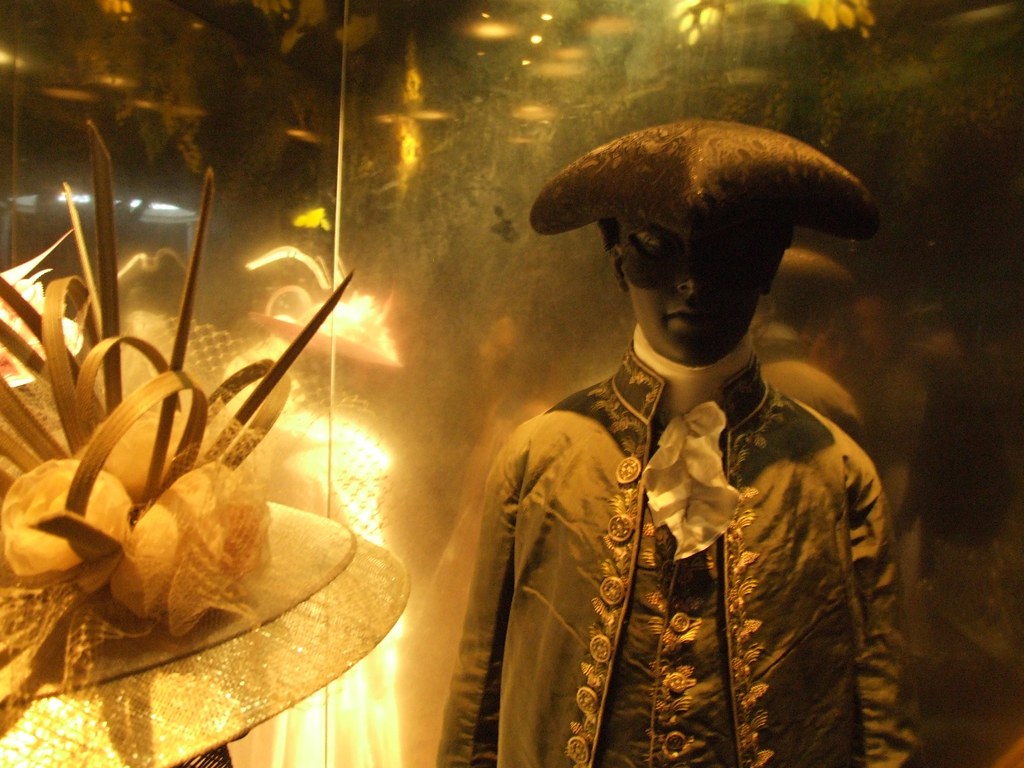
Costume from the Vauxhall Pleasure Gardens. A section of the Museum of London re-creating the Vauxhall Pleasure Gardens (before they slipped into disrepute): photo by B (falling_angel), 11 March 2011 (Museum of London)
.....“The English Garden.” -- Mason
The cold transparent ham is on my fork --
It hardly rains -- and hark the bell!-- ding-dingle --
Away! Three thousand feet at gravel work,
Mocking a Vauxhall shower! -- Married and Single
Crush -- rush; -- Soak’d Silks with wet white Satin mingle.
Hengler! Madame! round whom all bright sparks lurk
Calls audibly on Mr. and Mrs. Pringle
To study the Sublime, &c. -- (vide Burke)
All Noses are upturn’d! -- Whish-ish! -- On high
The rocket rushes -- trail -- just steals in sight --
Then droops and melts in bubbles of blue light --
And Darkness reigns -- Then balls flare up and die --
Wheels whiz -- smack crackers -- serpents twist -- and then
Back to the cold transparent ham again!
Thomas Hood (1799-1845): Sonnet to Vauxhall, 1839

Entrance to Vauxhall Gardens: Thomas Rowlandson (1756-1827) , water colour, 9 x 12 ins. (from H M. Cundall: Masters of Water-Colour Painting)
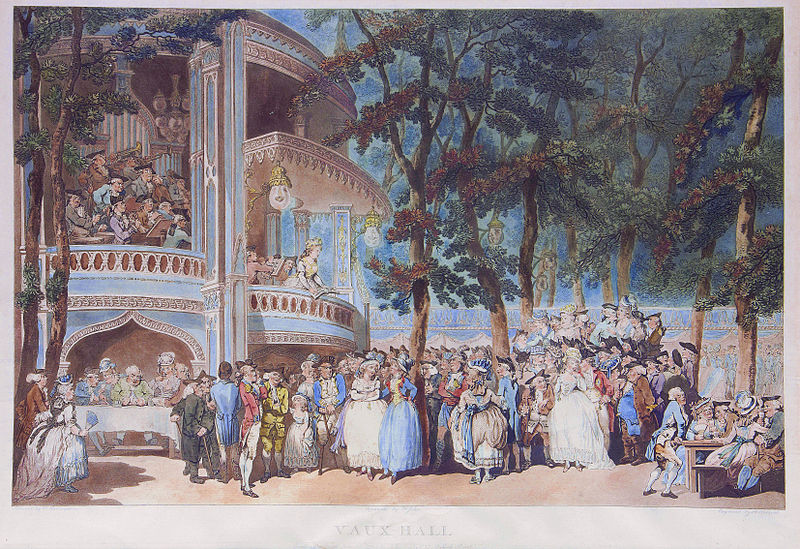
Vaux-Hall: Thomas Rowlandson (1756-1827), 20 June 1785, handcoloured etching with aquatint, on laid, 47.5 x 74.5 mm; aquatint by Francis Jukes (1745-1812); engraving by Robert Pollard (1755-1838)(Library of Congress)

Vauxhall Garden: aquatint, after a design by Thomas Rowlandson (1756–1827) and Augustus Charles Pugin (1762–1832) (after); engraving by John Bluck (fl. 1791–1819), Joseph Constantine Stadler (fl. 1780–1812), Thomas Sutherland (1785–1838), J. Hill, and Harraden (aquatint engravers) (from Rudolf Ackermann's Microcosm of London, 1809)

Tom, Jerry and Logic making the most of an Evening at Vauxhall: aquatint by George Cruikshank (1792-1878), in Robert and George Cruikshank: Life in London; or, the Day and Night Scenes of Jerry Hawthorn, Esq., and his Elegant Friend Corinthian Tom, Accompanied by Bob Logic, the Oxonian, in their Rambles and Sprees through the Metropolis (London, 1820-21) (Ohio State University Rare Books and Manuscripts Library)

Dr Syntax at Vauxhall Gardens: after Thomas Rowlandson, engraving, 1817 (private collection/The Foundling Museum, London)
...with my wife and the two maids, and the boy, took boat and to Foxhall, where I had not been a great while. To the Old Spring Garden, and there walked long, and the wenches gathered pinks. Here we staid, and seeing that we could not have anything to eat, but very dear, and with long stay, we went forth again without any notice taken of us, and so we might have done if we had had anything. Thence to the New one, where I never was before, which much exceeds the other; and here we also walked, and the boy crept through the hedge and gathered abundance of roses, and, after a long walk, passed out of doors as we did in the other place, and here we had cakes and powdered beef and ale, and so home again by water with much pleasure.
Samuel Pepys: diary entry for 29 May 1662
The chief part of the company having seated themselves in the arbours, five hundred separate suppers are served in an instant ... the price of a bottle of French claret is 5s., of one cold chicken 2s.6d., a quart of cyder 1s., a quart of small beer 4d. a slice of bread 2d. of cheese 4d., and everything else in proportion, which raises an elegant collation to a high rate.
The Scots Magazine, September 1739
The diversions of the times are not ill suited to the genius of this incongruous monster, called the public. Give it noise, confusion, glare, and glitter; it has no idea of elegance and propriety... Vauxhall is a composition of baubles, overcharged with paltry ornaments, ill conceived, and poorly executed.
Tobias Smollett: The Expedition of Humphry Clinker, 1771
Vauxhall Gardens is peculiarly adapted to the taste of the English nation; there being a mixture of curious show, -- gay exhibition, musick, vocal and instrumental, not too refined for the general ear; -- for all of which only a shilling is paid; and, though last, not least, good eating and drinking for those who choose to purchase that regale.
James Boswell, The Life of Samuel Johnson, 1791
We paid our shilling at the gate, and then we saw for the first time, that the entrance, if there had been any magic about it at all, was now decidedly disenchanted, being, in fact, nothing more nor less than a combination of very roughly-painted boards and sawdust. We glanced at the orchestra and supper-room as we hurried past -- we just recognised them, and that was all. We bent our steps to the firework-ground; there, at least, we should not be disappointed. We reached it, and stood rooted to the spot with mortification and astonishment. That the Moorish tower -- that wooden shed with a door in the centre, and daubs of crimson and yellow all round, like a gigantic watch-case! That the place where night after night we had beheld the undaunted Mr. Blackmore make his terrific ascent, surrounded by flames of fire, and peals of artillery, and where the white garments of Madame Somebody (we forget even her name now), who nobly devoted her life to the manufacture of fireworks, had so often been seen fluttering in the wind, as she called up a red, blue, or party-coloured light to illumine her temple!
Charles Dickens: Sketches by Boz, 1836
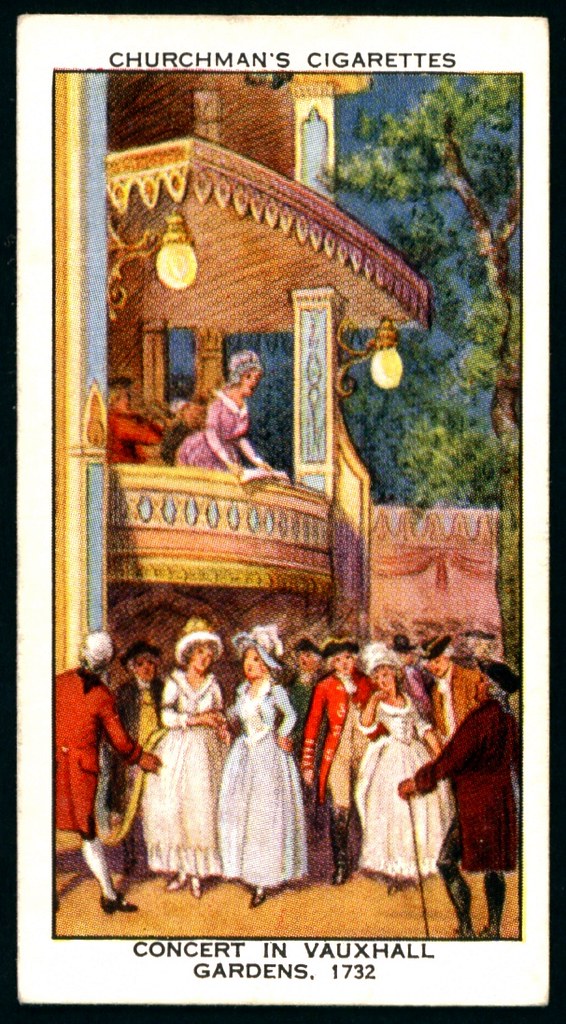
Cigarette card: Churchman's Cigarettes -- "The Story of London" (series of 50 issued in 1934): #32 Concert in Vauxhall Gardens, 1732: image by cigcardpix, 27 July 2012
Vauxhall Gardens, across the river in Lambeth, was originally a private estate, twelve acres of gardens opened to the public by Sir Samuel Morland in the Restoration; Pepys went there to eat lobster and syllabub, listening to the nightingales, the Jew's harp and the fiddles. The Vauxhall groves had been popular ever since and the dusky walks acquired an appropriately shady reputation which lasted until 1727 when the lease of this 'rural brothel' was taken by the twenty-six-year-old Jonathan Tyers. It was a bold move, to take the lease for thirty years at £250 a year, but one that proved so successful that Tyers eventually bought Vauxhall outright in the late 1750s...
In the season, from April or May until late August, the Gardens were open three times a week. Part of the charm of Vauxhall... was the trip by water. On summer evenings [visitors] might head for Westminster or Whitehall stairs, where wherries were always waiting, and glide across to join the scramble on the other bank a short way upstream... At the narrow landing stage the boats shoved and nosed their way in and there was always confusion, quarreling and swearing, but after the short walk up the lane the revellers entered a magic world.
In the season, from April or May until late August, the Gardens were open three times a week. Part of the charm of Vauxhall... was the trip by water. On summer evenings [visitors] might head for Westminster or Whitehall stairs, where wherries were always waiting, and glide across to join the scramble on the other bank a short way upstream... At the narrow landing stage the boats shoved and nosed their way in and there was always confusion, quarreling and swearing, but after the short walk up the lane the revellers entered a magic world.
Over the years Tyers added pavilions, supper boxes, statues, porticoes and colonnades and elaborate trompe l'oeil effects, and thousands remembered the shock of delight as they walked through the gates and saw the hundreds of lights glimmering through the trees. The orchestra played from seven until nine ('new songs from Vauxhall' were always in vogue) and then broke for supper; chicken and beef and ham of legendary thinness, cheesecakes and tarts, strawberries and sweet custard, port for the men and hock and sherry for the ladies. As dusk turned to dark and couples began to wander off into the groves, flirtation began in earnest.
Vauxhall brought down on Tyers' head exactly the sort of criticism that [had attended the] masquerades -- accusations of sexual licence, assignations and, worst of all, an indiscriminate mixing of class, allowing footmen to dally with countesses and clergymen with parlourmaids. One anonymous critic... thought this false, erotic, Arcadian blurring of levels brought nothing but harm, simply transporting the dissolute Covent Garden world to the other bank of the Thames:
From Drury's bounds see shining Throngs repair
With borrow'd charms to breathe in sweeter Air;
With borrow'd charms to breathe in sweeter Air;
From stinking Rags and lofty Garret free'd,
Lo! Oyster Betty shines in soft Brocade,
Lo! Oyster Betty shines in soft Brocade,
See Fops and Haggs dress out, a Glitt'ring Show!
Each Barber's Prentice makes a powder'd Beau...
Each Barber's Prentice makes a powder'd Beau...
Tyers tried hard to oblige 'the Polite and Worthy Part of the Town, by doing everything in his Power that may contribute to their Ease and Pleasure' and keeping the riff-raff out, 'such as are not fit to intermix with these Persons of Quality'. He worked to exclude prostitutes and pimps... But, as at the masquerade, the crossing of boundaries was part of the charm. The Vauxhall crowd on a soft June night brought all London's worlds together...
Jenny Uglow: Hogarth, A Life and a World, 1997

A General Prospect of Vaux Hall Gardens: engraving by J.S Muller after Samuel Wale, 1751 (private collection)

The Grand Walk, Vauxhall Gardens, London: Antonio Canaletto, c. 1751 (Collection Compton Verney)
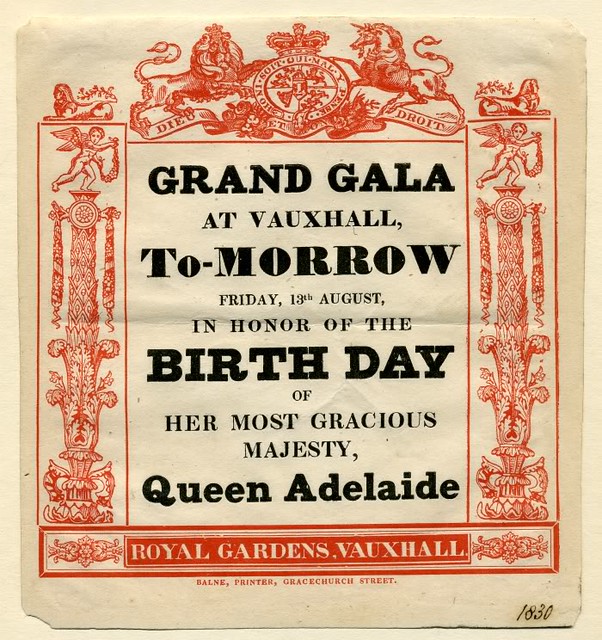
Vauxhall Gardens ephemera printing, 1830: printed by Balne and Co.; image by sos222 (Stephen Saxe), 29 October 2010
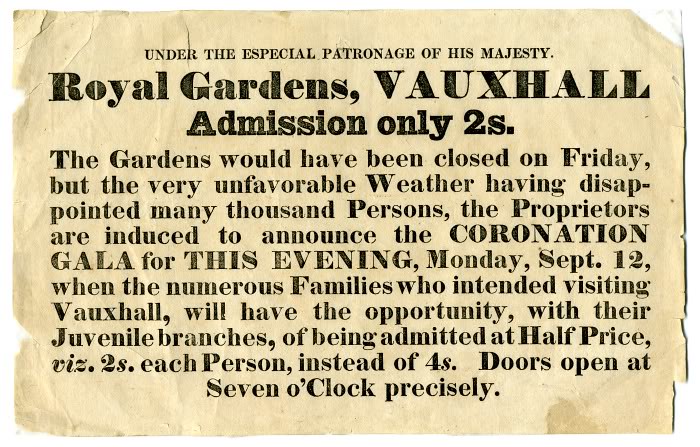
Vauxhall Gardens ephemera printing, 1831: printed by Balne and Co.: image by sos222 (Stephen Saxe), 29 October 2010
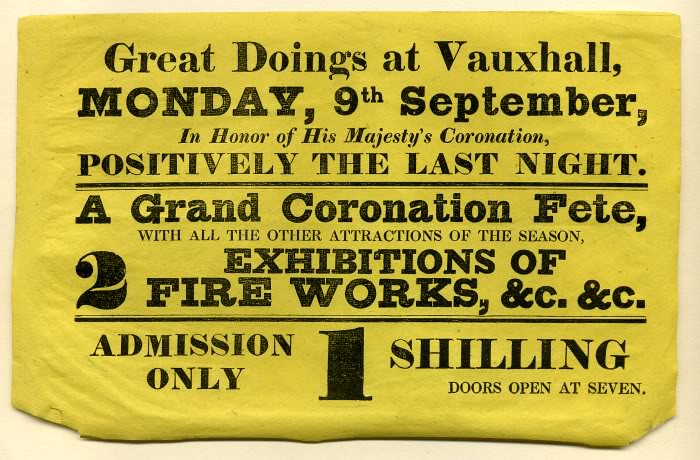
Vauxhall Gardens ephemera printing, c. 1833: printed by Balne and Co.: image by sos222 (Stephen Saxe), 29 October 2010
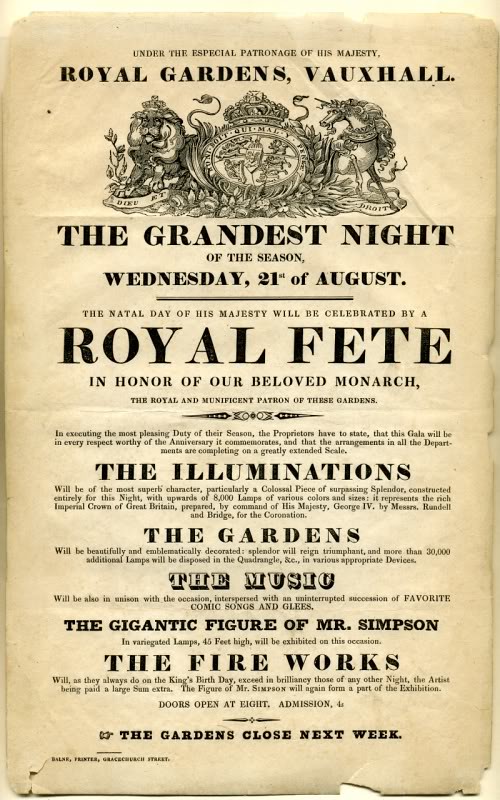
Vauxhall Gardens ephemera printing, 1833: printed by Balne and Co.: image by sos222 (Stephen Saxe), 29 October 2010

Vauxhall Gardens, London, 1817: engraver unknown; image by lili kamille (lilikk), 25 February 2010

Vauxhall Pleasure Gardens: Ascent of the Vauxhall Balloon and Mr. Cocking's Parachute: artist unknown, from The Mirror, Saturday 29 July, 1817; image by Dan Tassell, 21 January 2011
Poster advertising Vauxhall Gardens closing night, Monday 26 July 1859. It was dubbed the ‘Last Night For Ever’. People sang, horses performed in The Rotunda and finally, after some dancing, visitors watched a firework display entitled ‘Farewell for Ever": via Museum of London
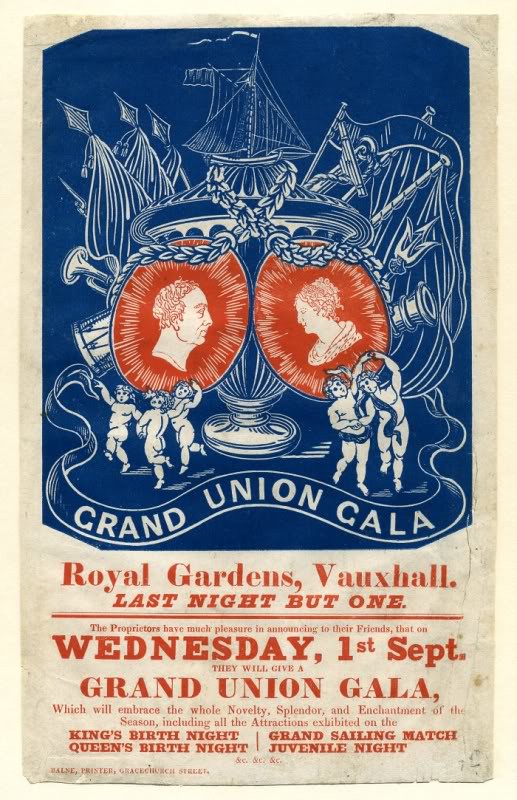
Vauxhall Gardens ephemera printing, 1830: printed by Balne and Co.; image by sos222 (Stephen Saxe), 29 October 2010

Vauxhall Gardens ephemera printing, 1838: printed by Baine and Co .; image by sos222 (Stephen Saxe), 29 October 2010
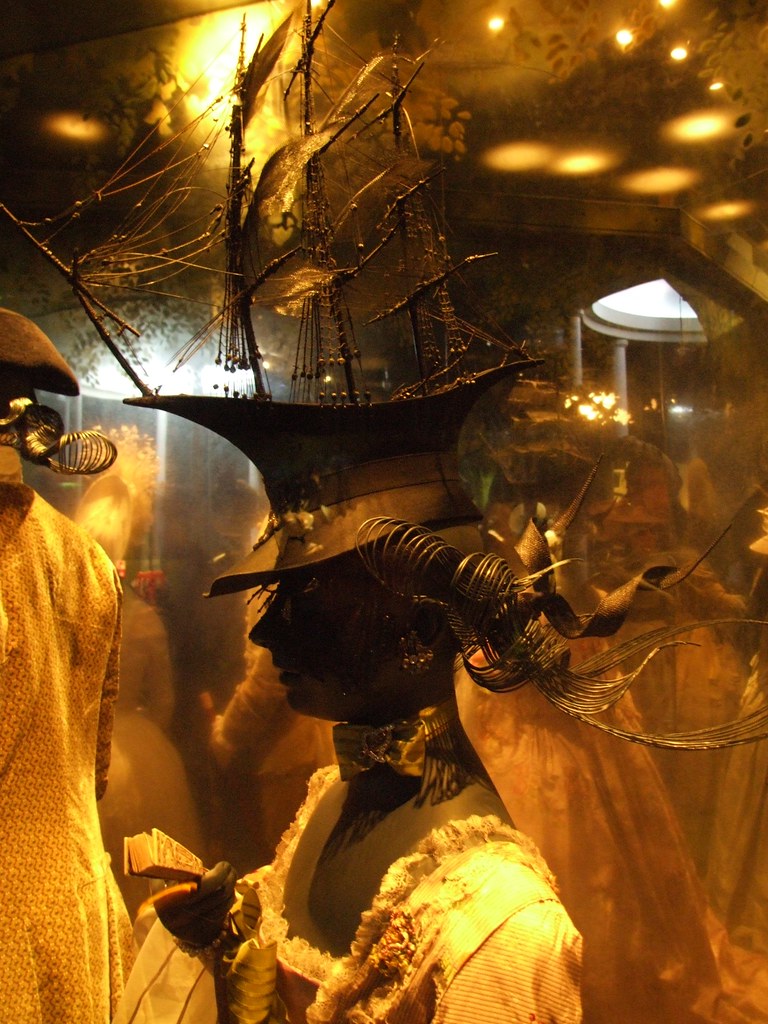
Costume from the Vauxhall Pleasure Gardens. A section of the Museum of London re-creating the Vauxhall Pleasure Gardens (before they slipped into disrepute): photo by B (falling_angel), 11 March 2011 (Museum of London)
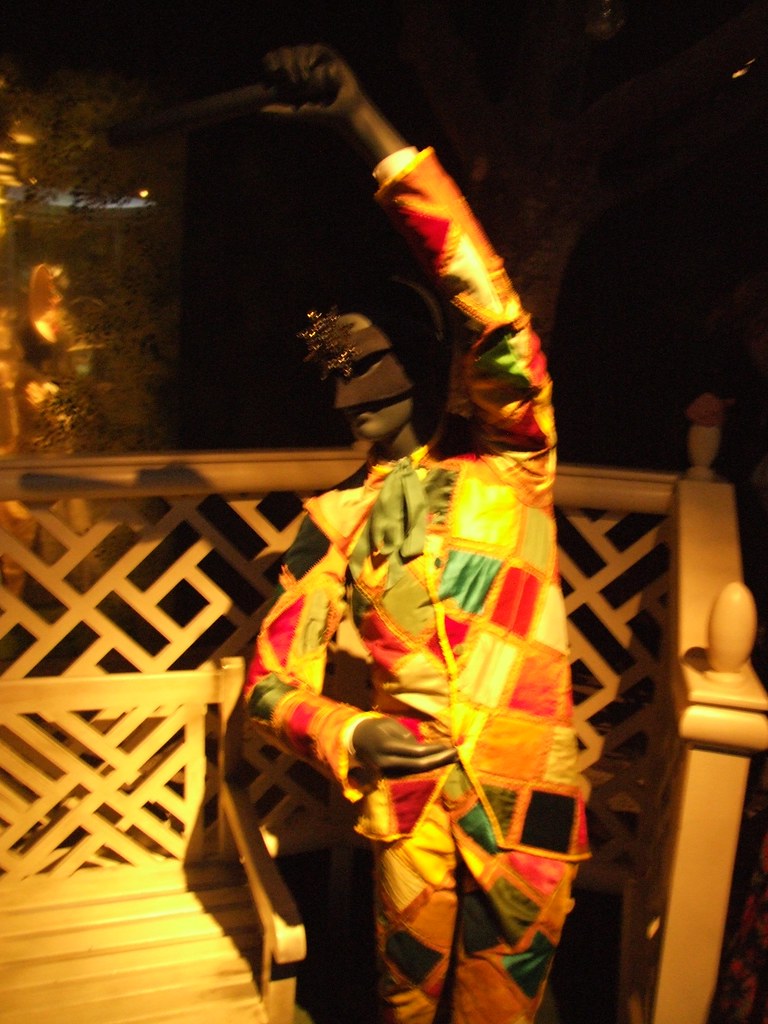
Costume from the Vauxhall Pleasure Gardens. A section of the Museum of London re-creating the Vauxhall Pleasure Gardens (before they slipped into disrepute): photo by B (falling_angel), 11 March 2011 (Museum of London)

Costume from the Vauxhall Pleasure Gardens. A section of the Museum of London re-creating the Vauxhall Pleasure Gardens (before they slipped into disrepute): photo by B (falling_angel), 11 March 2011 (Museum of London)
Costumes from the Vauxhall Pleasure Gardens. A section of the Museum of London re-creating the Vauxhall Pleasure Gardens (before they slipped into disrepute). The Vauxhall Gardens ran from the mid 17th century to the mid 19th century. The site was known as Vauxhall Gardens from 1785 with admission charged for entry into a range of entertainments. The rococo "Turkish tent" became one of the Gardens' structures, the interior of the Rotunda became one of Vauxhall's most viewed attractions, and the chinoiserie style was a feature of several buildings. The "last night" of the gardens was 5 September 1839 attracting 1089 people. It did re-open until 1859, when it closed, when was sold off for building (Museum of London)
